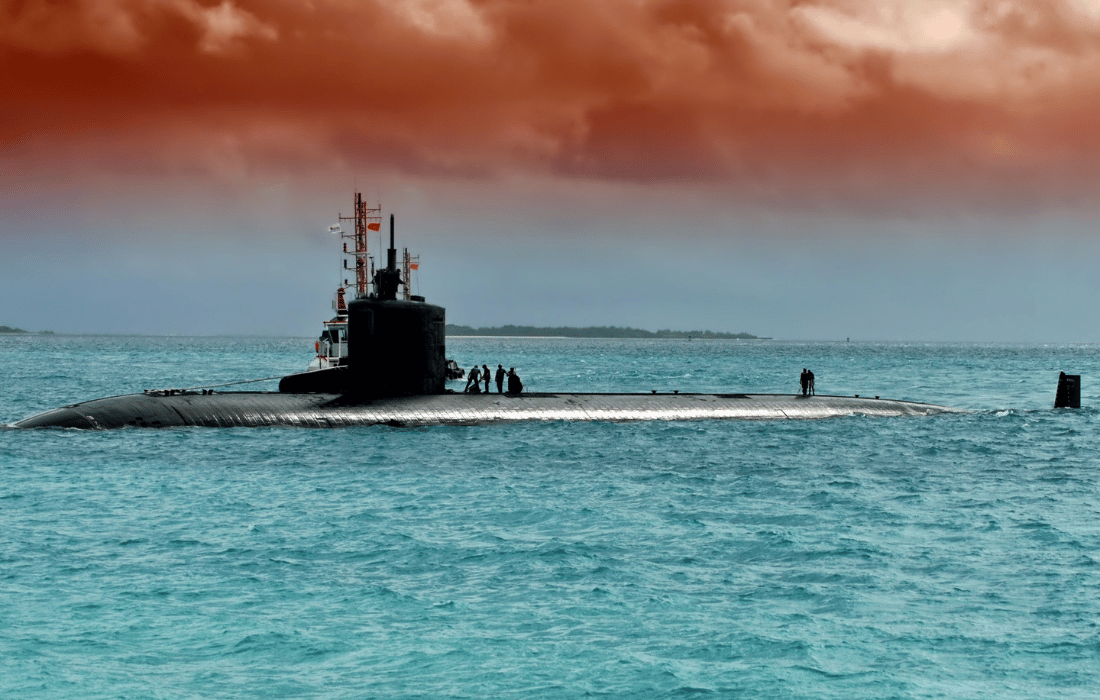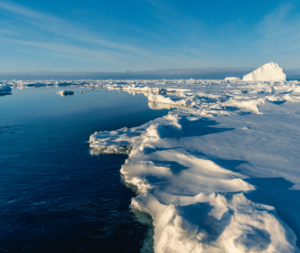Nuclear-powered vessels are marvels of modern engineering, allowing submarines, aircraft carriers, and icebreakers to operate with extraordinary range and efficiency. These vessels represent massive technological and strategic advancements, serving crucial roles in military, scientific, and exploratory missions.
As it often is though, there is a concerning environmental issue beneath the surface of all this innovation: radioactive water trails. These discharges, often totally invisible, pose a pretty serious threat to the future of marine ecosystems and human health. In this blog, we’ll lay out the origins of these radioactive trails, their impacts, and what can be done to address them.
How Nuclear Vessels Work
Nuclear-powered vessels operate using onboard nuclear reactors, which generate energy through a process called nuclear fission. This involves splitting atoms, typically of uranium or plutonium, to release a tremendous amount of heat. The heat is used to produce steam, which drives turbines to propel the vessel or generate electricity for onboard systems.

To maintain safe operating temperatures, these reactors rely on complex cooling systems. Water is often the medium used to carry heat away from the reactor core. While most of this water is recycled within the vessel, some of it is discharged into the surrounding environment. These discharges can contain radioactive isotopes, creating what is known as a radioactive water trail.
In addition to propulsion, nuclear reactors on vessels are used to power advanced radar systems, desalination processes, and other critical operations. This increases the complexity of managing radioactive waste, as multiple systems contribute to potential contamination risks.
Understanding Radioactive Water Trails
Radioactive water trails result from the interaction between nuclear vessel operations and their surrounding aquatic environment. They can originate from several sources:
- Routine Discharges: During normal operations, some radioactive coolant water is released into the sea. These discharges are often permitted under regulatory frameworks but still contribute to environmental contamination.

- Accidental Leaks: Equipment failures or human errors can lead to unintended releases of radioactive material. Even small leaks can have significant environmental consequences over time.
- Improper Waste Management: Disposal of radioactive waste from maintenance or decommissioning activities can result in contamination if not handled properly.
Another concerning source includes the decommissioning of aging nuclear vessels. Improper dismantling processes or inadequate storage of spent reactor components can lead to significant radioactive contamination in local water bodies.
Environmental Impacts of Radioactive Water Trails
The release of radioactive isotopes into marine environments has profound ecological and health implications:
Contamination of Marine Ecosystems
 Radioactive isotopes such as cesium-137 and strontium-90 can persist in the environment for decades. These isotopes are absorbed by marine organisms, entering the food chain through a process called bioaccumulation. Over time, predators, including larger fish and marine mammals, accumulate higher concentrations of radioactivity, disrupting ecosystems and threatening biodiversity.
Radioactive isotopes such as cesium-137 and strontium-90 can persist in the environment for decades. These isotopes are absorbed by marine organisms, entering the food chain through a process called bioaccumulation. Over time, predators, including larger fish and marine mammals, accumulate higher concentrations of radioactivity, disrupting ecosystems and threatening biodiversity.
Coral reefs, often considered the “rainforests of the sea,” are particularly vulnerable. Exposure to radioactive materials can impair coral growth and reproduction, leading to cascading effects on the species that depend on these habitats.
Risks to Human Health
Humans who consume seafood contaminated with radioactive isotopes face increased risks of cancer, genetic mutations, and other health issues. Communities near naval bases or shipping routes of nuclear vessels are particularly vulnerable to these risks, especially if water sources are contaminated.
Studies have also linked radioactive exposure from environmental sources to thyroid disorders, a condition exacerbated by isotopes like iodine-131. These health risks underline the urgent need for stricter monitoring and regulation.

Global Examples and Case Studies
The impact of radioactive water trails is not just theoretical. Several documented cases highlight the severity of the issue:
Historical Incidents
- Soviet-Era Submarine Leaks: During the Cold War, several Soviet nuclear reactors and submarines experienced accidents that led to radioactive contamination in the Arctic Ocean. These incidents remain a source of pollution decades later.
- Fukushima Daiichi Spill: While primarily a civilian nuclear disaster, the Fukushima incident underscored the challenges of radioactive water management, especially as contaminated water reached the Pacific Ocean. It also highlighted the interconnectedness of nuclear technology across civilian and military sectors.
Current Practices
Modern nuclear-powered navies, such as those of the United States, Russia, and China, operate under strict regulations. However, disparities in enforcement and transparency mean that discharges often go underreported or inadequately monitored. In some regions, the lack of independent oversight further complicates efforts to assess the true extent of contamination.
Regulatory Oversight and Challenges
Several international agreements and organizations aim to mitigate the environmental impact of radioactive discharges from nuclear vessels:
- MARPOL (International Convention for the Prevention of Pollution from Ships): This treaty addresses various types of marine pollution but offers limited provisions for radioactive waste.
- International Atomic Energy Agency (IAEA): The IAEA provides guidelines for managing radioactive materials but lacks enforcement power for naval operations.
Challenges
- Limited Enforcement: International waters often lack stringent oversight, allowing nuclear vessels to operate without accountability.

- Varying Standards: Different countries have different thresholds for permissible radioactive discharges, leading to inconsistent environmental protection.
- Geopolitical Considerations: In areas of military tension, environmental concerns often take a backseat to strategic priorities, further exacerbating the problem.
Technological and Policy Solutions
Reducing the environmental impact of nuclear vessels requires both technological innovations and policy reforms:
Advances in Technology
- Improved Reactor Designs: Next-generation nuclear reactors, such as small modular reactors (SMRs), promise greater efficiency and lower risk of radioactive leaks. These designs incorporate enhanced safety features and reduced waste outputs.

- Alternative Cooling Methods: Research into non-water-based cooling systems, such as air-cooled designs, could eliminate the need for discharges into marine environments. Additionally, closed-loop cooling systems can minimize environmental exposure.
Policy Recommendations
- Stricter Regulations: International bodies need to adopt and enforce more stringent standards for radioactive discharges from nuclear vessels. This includes mandatory reporting of all discharges, routine or accidental.
- Transparency and Monitoring: Real-time monitoring of discharges and public reporting can build accountability and incentivize better practices. Independent environmental organizations should play a role in auditing these activities.
- Investment in Cleanup Technology: Governments and private stakeholders should fund initiatives to clean existing contamination, such as advanced filtration and isotope neutralization technologies.
The Public’s Role
Public awareness and advocacy are crucial in addressing the issue of radioactive water pollution. Individuals can:
- Support Environmental Organizations: Groups focused on nuclear safety and marine conservation play a vital role in holding governments and industries accountable.
- Push for Policy Change: Citizens can advocate for stricter regulations through petitions, awareness campaigns, and by engaging with policymakers.
- Demand Corporate Responsibility: Companies involved in nuclear technology must be encouraged to adopt sustainable practices and prioritize environmental health.
Closing Thoughts
Nuclear-powered vessels are undeniably a key player in our current global infrastructure and defense. However, their typically hidden environmental costs, particularly the creation of radioactive water trails, cannot be ignored. From disrupting marine ecosystems to threatening human health, the impact of these discharges underscores the need for better oversight, technological innovation, and public accountability.
Balancing technological progress with environmental responsibility is not just an ideal – it’s a necessity for the health of the people and our planet. By advocating for change and supporting sustainable practices, we can mitigate the pollution from these powerful nuclear vessels and protect future generations. Addressing this issue is not only a scientific or policy challenge but also a moral imperative for a healthier, more sustainable world.












